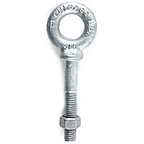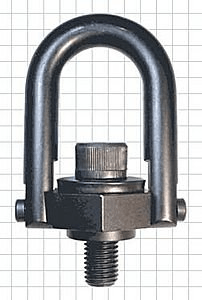By the title of this article you can see that I really favor the use of hardware which maintains a dependable rated capacity even when rigging conditions aren't that dependable. Also, versatility is key to many rigging jobs, and that is almost always guaranteed when comparing swivel hoist rings to shoulder eyebolts.
 1) Temperature range is certainly a consideration when selecting rigging hardware. The consensus temperature range agreed to during the development of ASME B30.26 RIGGING HARDWARE Chapter 2 (Adjustable Hardware) is 30˚ F to 275˚ F for a carbon steel shoulder eyebolt. The consensus temperature range for a swivel hoist ring is -20˚ F to 400˚ F. Certain hardware manufacturers can provide these two types of lifting components with operational temperature ranges that exceed the consensus stated above. Check for the products that you own.
1) Temperature range is certainly a consideration when selecting rigging hardware. The consensus temperature range agreed to during the development of ASME B30.26 RIGGING HARDWARE Chapter 2 (Adjustable Hardware) is 30˚ F to 275˚ F for a carbon steel shoulder eyebolt. The consensus temperature range for a swivel hoist ring is -20˚ F to 400˚ F. Certain hardware manufacturers can provide these two types of lifting components with operational temperature ranges that exceed the consensus stated above. Check for the products that you own.
2) A swivel hoist ring can rotate to the direction of force using its swivel bushing, with no loss of rated capacity. A shoulder eyebolt might need to be shimmed before final seating, to achieve the "in-line" loading orientation necessary for use. If the angle from horizontal is less than 85˚, there is a recordable loss of rated capacity for a shoulder eyebolt.
3) The bail of a swivel hoist ring pivots at the swivel bushing, allowing it to align itself to the direction of force in a 90˚ arc, without experiencing a loss of capacity. The shoulder eyebolt experiences a loss of capacity in graduated steps (at angles from horizontal) 84˚ to 75˚ = 45% loss and then 74˚ to 0˚ = 75% loss.
4) The rated capacity, torque requirements and manufacturer's name or trademark are required to be marked on a swivel hoist ring. The size or rated capacity, grade and manufacturer are required to be identified on an eyebolt. Unless special made, shoulder eyebolts do not have their rated capacity marked or identified on them. Their capacity must generally be discovered through document research of the manufacturer's specifications, which is not easily accessible in the field.
Accidents can occur if either of these rigging hardware components are abused, misused, overloaded or shock loaded. The reader is encouraged to consider using well seated shoulder eyebolts in a vertical loading application only. They lose too much capacity, too fast, at angles less than 85˚ from horizontal.
Though both require qualified inspection and proper application, the swivel hoist ring is a much more realistic and capable type hardware anytime angles from vertical must be rigged and especially when load turning might be encountered. Remember, a swivel hoist ring needs to be able to rotate and pivot without interference during lifting.
To gain much more experience rigging with swivel hoist rings and shoulder eyebolts, consider attending ITI's Master Rigger Training program in the near future. This is the most comprehensive training program in the industry that focuses half of its time on hands-on training.
Happy trails to all my crane and rigging friends,
Mike Parnell, Technical Director, ITI




COMMENTS